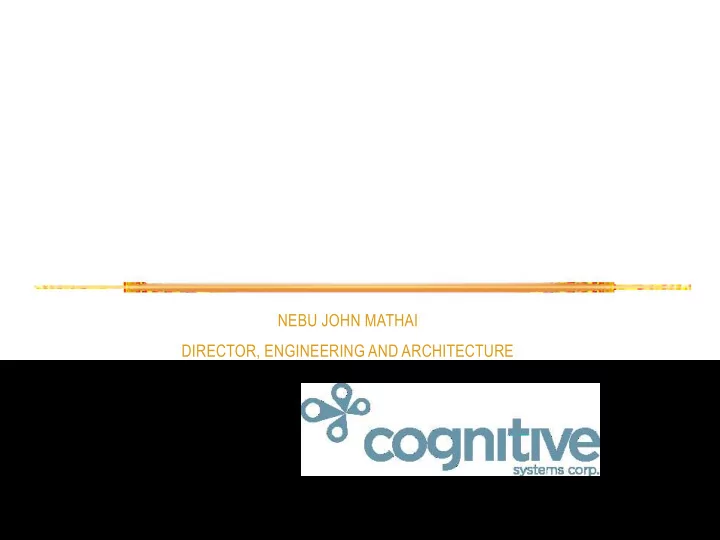

COMPUTER ARCHITECTURE & SOFTWARE-DEFINED RADIO NEBU JOHN MATHAI DIRECTOR, ENGINEERING AND ARCHITECTURE
INTRODUCTION Higher Communications Performance System Substrates Architects Increased Hardware Algorithm Architects Complexity More Performance
COMPUTER ARCHITECTURE SDR New standards, New uses Higher SDR performance Novel Computer Architectures
TRENDS • Communications standards complexity Algorithmic diversity • • Large parameter spaces Cross-stack communication • • Processing power • Flexibility • Better Language/Compilers • Express complex ideas correctly • Efficient mapping
TRENDS • IOT: Boldly going where no radio has gone before Power consumption • • Flexibility Malleability • • High Performance Computing Scaling: both directions • Edge Edge Big Big • Power efficiency Computing Computing Compute Compute Architectural diversity • HPC
OVERVIEW • Quick look at history Computer architecture SDR •
HISTORY Computation • C.E. Shannon Digital Hardware Engineering • • Information Theory A. N. Kolmogorov • Control Communications • Algorithmic Information Theory N. Wiener, W.R. Ashby, … • • systems { convey, store, process } information for control
HOW DID WE GET HERE? Analog to • Constraints and Requirements Digital • New standards and interfaces • IOT: malleability, performance, power economy Hard Digital • Cognitive radio: same to Soft Digital Advanced sensing: high-performance • Canonical to exotic HPC
COMPUTATION • Map: math -> physical substrate Analog • • Variables analogous to physical quantities Transistors in linear region • • Digital Variables are analogous to abstractions • • Transistors in discrete on/off states
1. (A2D) ANALOG COMPLEXITY • Design Complexity Verification Complexity • • Simulation • Mismatch: ODE and digital computers • Simplifications Validation Complexity • • Smaller-scale vital systems
1. (A2D) DIGITAL SOLUTIONS • Arbitrary precision, dynamic range H(z) => hardware implementation • • Control flow Scalability • • Tractable Verification + Validation Discrete-time simulation directly maps to digital computers • • Integration with software stack
1. (A2D) REPERCUSSIONS complexity Analog Analog Hard digital Hard digital Soft digital Soft digital • Verification Complexity State space explosion • • Adequate stimulation requires lots of time Simulation: orders of magnitude slower than real time • • How to practically ensure you’ve covered all cases?
2. (H2S) MAKE IT SOFTWARE’S PROBLEM Digital Front End Digital Front End Control Knobs Control Control Processor Processor • Add knobs to the digital front end When it becomes impractical to control the knobs … • • … develop schemes to control them via a processor
2. (H2S) MAKE IT SOFTWARE’S PROBLEM • Solves the Design + Verification problem: Processors are well-known systems • • Adding features: easy Achieving performance: hard • Innovative architectures to address this •
3. ARCHITECTURES: BASIC Instruction Instruction RAM RAM Data Input Data Input Data Output Data Output … RAM RAM RAM RAM Functional Units
3. ARCHITECTURES: DSP Instruction Instruction RAM RAM Data Input Data Input Data Output Data Output … RAM RAM RAM RAM More Functional Units
3. ARCHITECTURES: SIMD Instruction Instruction RAM RAM Data Input Data Input Data Output Data Output … RAM RAM RAM RAM Parallel Functional Units
3. ARCHITECTURES: MIMD Instruction Instruction RAM RAM Data Input Data Input Data Output Data Output … RAM RAM RAM RAM Parallel Independent Functional Units
3. ARCHITECTURES: VLIW Instruction Instruction RAM RAM Data Input Data Input Data Output Data Output RAM RAM RAM RAM
3. ARCHITECTURES: GRID
3. HETEROGENEOUS SYSTEMS • Demanding Hardware architecture, design and verification • • Software engineering Worthwhile • • Ideal performance characteristics
Recommend
More recommend